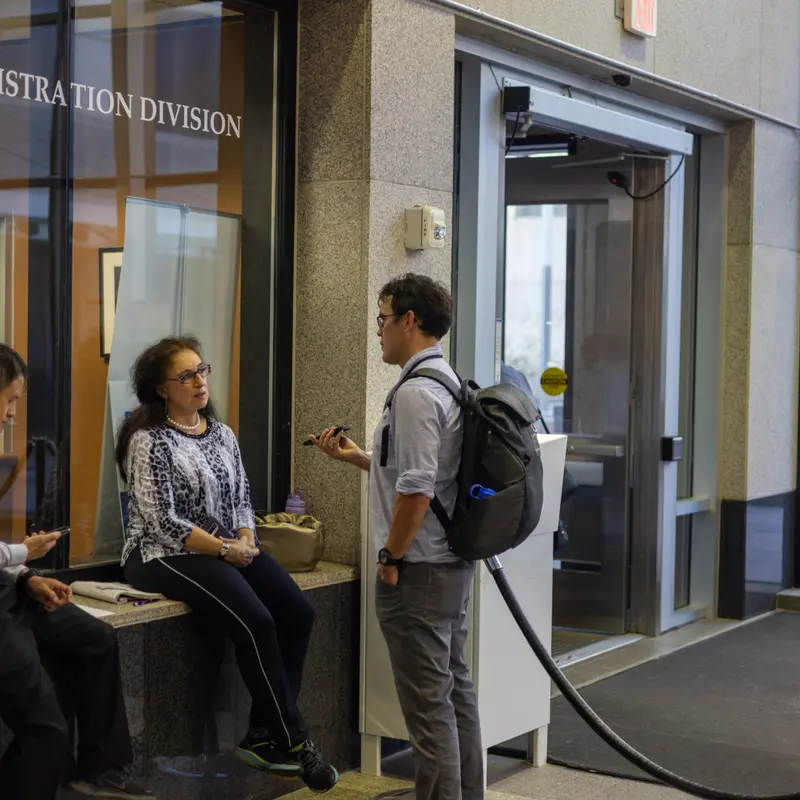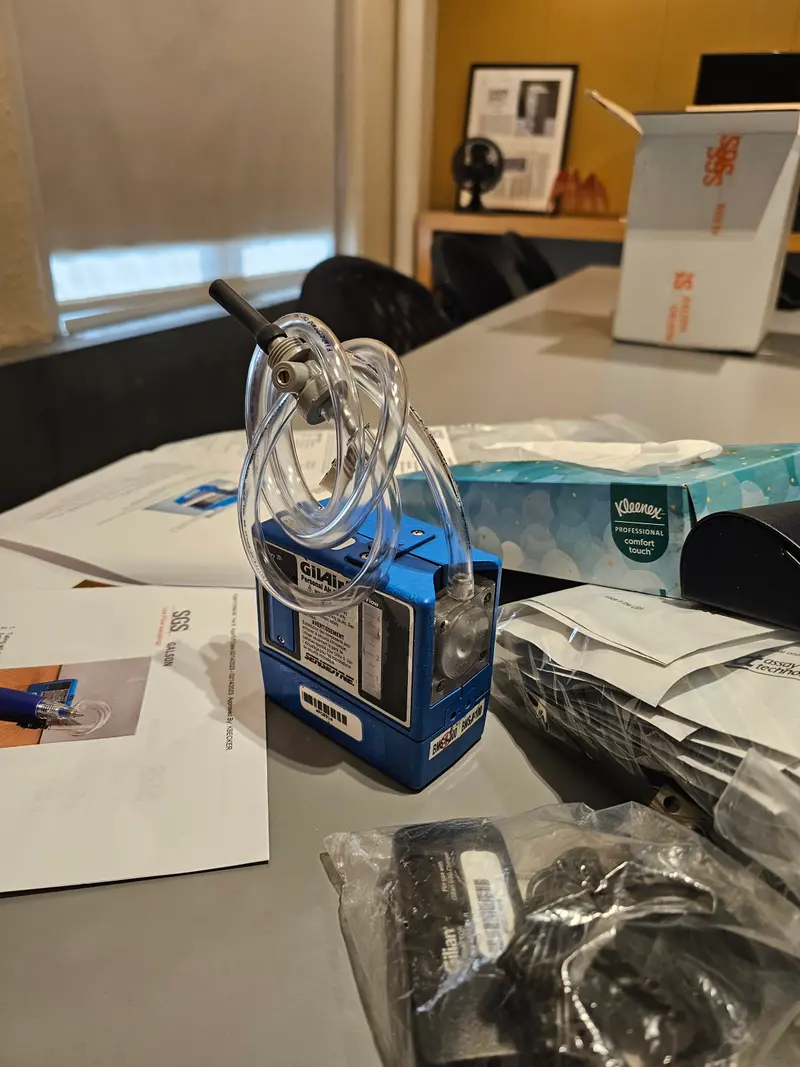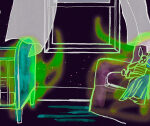ProPublica is a nonprofit newsroom that investigates abuses of power. Sign up to receive our biggest stories as soon as they’re published.
Reporting Highlights
- Invisible Danger: Formaldehyde, a colorless pungent gas, can cause cancer, breathing problems and reproductive harms.
- Greatest Threat: Most of us face the highest risks in our homes, where formaldehyde is released by some types of furniture, gas stoves and other everyday products.
- Our Testing: We found concerning levels of formaldehyde in furniture stores, inside a nail salon, in cars and at a dinner party.
These highlights were written by the reporters and editors who worked on this story.
The air was packed with savory and sweet aromas when I walked into my colleague’s Brooklyn apartment for dinner. The sizzle and pop of rice and green beans cooking on the gas stove blended with soft jazz coming from the TV. Candle flames danced and flickered.
But we weren’t gathering just to enjoy a late-summer meal. We were trying to expose an uninvited yet ever-present guest — formaldehyde.
The invisible chemical can be harmless in small amounts, but in larger concentrations, it can cause headaches, dizziness, respiratory illness and asthma. It is also responsible for more cancer than any other toxic air pollutant.
Because of its importance to many industries, formaldehyde has proven difficult to regulate. This year, President Joe Biden’s administration finally appeared to make some progress, though it was modest. If the past is any guide, however, even those limited efforts are likely to hit a dead end after Donald Trump is inaugurated. Knowing our risks is essential to protecting ourselves, experts say. Last week, ProPublica published a tool to show how much formaldehyde is in the outside air.
But our biggest exposure happens indoors, so my colleagues and I set out to do our own testing.
We read thousands of pages of scientific studies and Environmental Protection Agency documents on the dangers of formaldehyde, and we learned the toxic chemical is nearly impossible to escape. Formaldehyde is in furniture and flooring. It is in the adhesives used in wallpaper and carpets. It’s given off by candles, fireplaces and gas stoves. And it’s in hair products and cosmetics.
Good journalism makes a difference:
Our nonprofit, independent newsroom has one job: to hold the powerful to account. Here’s how our investigations are spurring real world change:


The Supreme Court created its first-ever code of conduct after we reported that justices repeatedly failed to disclose gifts and travel from the ultrawealthy.



Support ProPublica’s investigative reporting today. Donate Now
We’re trying something new. Was it helpful?
EPA scientists recently examined how low formaldehyde levels should be to ensure the chemical doesn’t trigger an allergic reaction, breathing problems or asthma symptoms, and the concentrations found inside the average home were far above that. Over a lifetime of exposure to the formaldehyde in an average home, a person’s risk of developing cancer is more than 250 times the risk level that the Clean Air Act sets as a goal. Even that number vastly underestimates the risk from cancer because the EPA did not factor in the chance of developing myeloid leukemia, the most common cancer caused by the chemical.
“It is everywhere, it is in everything,” University of California, Los Angeles researcher Nicholas Shapiro told me. Shapiro, who has spent years studying formaldehyde exposure, is working on a book, “Homesick,” that explores how formaldehyde, among other toxic chemicals in our homes, poses a danger to our health. “It is holding together our built environment and also chemically corroding us at the same time. It’s part of the fundamental paradox of the world that we’ve built, where this chemical is holding together our homes. We have built our society around it.”
My colleague Sharon Lerner and I traveled around New York City and New Jersey for weeks with equipment to measure the chemical’s presence.
The results proved concerning.
Out on the Town



Credit:
Topher Sanders/ProPublica
Sharon and I took a moment to wipe the July sweat from our brows as we got our testing equipment ready in a sprawling shopping center in Brooklyn. I placed a pump about the size of a large tape measure into Sharon’s backpack. The pump pulled in air through a two-foot rubber hose that extended out of the backpack’s main compartment.
I turned on the pump, which made a soft pneumatic sound. We were ready to ride the escalator up to an Ashley Furniture showroom in the Industry City mall.
“Can I help you guys find something?” a friendly salesperson asked.
“We’re just looking, thanks,” I replied.
We hoped the hose sticking out of Sharon’s backpack and the sound of the pump wouldn’t lead to more questions. For the next 20 minutes, we perused the showroom, opening cabinets, dressers and nightstands.
The store offers a wide range of budget furniture that can be made with foams, adhesives and wood composites that contain formaldehyde. These products go through a process called off-gassing, where chemicals they contain are released into the air over time. New furniture right out of the box has been shown to off-gas more than pieces that have been sitting out of their packaging for a while.
[Formaldehyde] is holding together our built environment and also chemically corroding us at the same time. It’s part of the fundamental paradox of the world that we’ve built, where this chemical is holding together our homes. We have built our society around it.”
Inside Ashley, it was hard to ignore the pungent fresh-furniture scent that wafted out of an opened cabinet or dresser. Sure, the furniture smelled, but we had no idea how much, if any, formaldehyde was present. The pump in Sharon’s backpack was collecting the air and any formaldehyde into a glass tube. As soon as we walked out, we placed the tube in a small cooler so we could send it to a lab for testing later.
We had other ideas about where to test. Sharon and another ProPublica colleague found a nail salon near New York City’s famed Canal Street. Some nail hardeners and polishes contain formaldehyde that may be listed on the product label as formalin or methylene glycol, according to the Food and Drug Administration. Also some nail polishes contain a toluenesulfonamide-formaldehyde resin that’s used to make the polish more resilient and adhere better to fingernails.
Standing on the busy sidewalk outside the salon with tourists buzzing by, I helped prepare the testing equipment. Once Sharon was inside, an employee soaked her hands and nails, then slathered them with goos, gels and paints. The air was acrid. The employee wore a disposable face mask, but other workers were unmasked as they clipped, sanded and shellacked customers’ nails.
A week or so later, I visited a Raymour & Flanigan furniture store in northern New Jersey. The sales folks didn’t pay much attention to me, so I didn’t have to worry about having an awkward conversation about the sound of the pump in my backpack. I walked around for more than 20 minutes, opening nightstand and dresser drawer.
Sharon and I stopped by a mall store that sells luxury soaps and lotions. We visited a cosmetics shop, a carpet store and a candle specialist. We packed up the air samples we collected and sent them to a certified industrial hygiene lab in Syracuse, New York, and waited.

Credit:
Topher Sanders/ProPublica
The EPA has determined that continuous daily exposure to concentrations of formaldehyde above 7 micrograms per cubic meter of air may cause decreased lung function, trigger allergic reactions and worsen asthma symptoms. Children and older people with asthma can be especially sensitive. It can be hard for doctors to identify formaldehyde as the reason for these kinds of reactions because it doesn’t linger in our bodies and there isn’t a medical or laboratory test that can accurately measure the amount of formaldehyde you may have been exposed to.
The chemical’s impact on our bodies can intensify dramatically the longer we are exposed. For instance, the EPA found that exposure to any amount of formaldehyde above a tiny concentration (0.09 micrograms per cubic meter) elevates people’s lifetime cancer risk beyond the goal the agency set. If the agency included the risk of developing myeloid leukemia in that calculation, that tiny concentration would be even smaller (0.023 micrograms).
When the lab emailed me the results, it revealed that our air sample from Ashley contained the highest levels of formaldehyde in our testing — 13 times the amount the EPA says is low enough to prevent issues like asthma, decreased lung function and respiratory irritation. Other results were also concerning. The nail salon had a concentration more than 6 times the level the EPA says would prevent breathing problems. Raymour & Flanigan’s concentration was more than 7 times the safe level. Federal regulators have set limits on how much formaldehyde some composite woods can release. But those limits are still well above the level EPA scientists established to prevent allergic reactions and other health problems.
A person’s risk depends not just on the chemical’s concentration but on how long they’re exposed. At the places we went, Sharon and I had been





